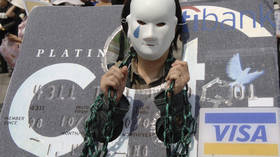Iran designing ‘modern’ uranium fuel, could restart enrichment 'in 4 days' - official
Tehran set off international concern after saying it is “on the verge” of producing 20 percent enriched fuel, later adding that it could restart currently banned uranium enrichment if it quits 2015 international deal.
EDITOR’S NOTE: An earlier version of this article concerning the implications of Iran’s words on nuclear fuel was revised following expert input and clarification. The text was also expanded and updated to include the latest statements from Ali Akbar Salehi.
“Initial measures have been started for the design of modern 20 percent fuel and we’re on the verge of achieving it,” Ali Akbar Salehi, head of the Atomic Energy Organization of Iran, told local media over the weekend. “We have made such progress in nuclear science and industry that, instead of reverse-engineering and the use of designs by others, we can design new fuel ourselves.”
Also on rt.com Iranian warships in US’ backyard? Tehran to deploy navy to western Atlantic – commanderMultiple media outlets reported that this could place Tehran in breach of the JCPOA agreement it negotiated in 2015 with Russia, China, the EU, Britain and Germany and the US. The statement was interpreted as a potential response to US President Donald Trump’s decision last year to abandon the deal, which had offered the Islamic Republic sanctions relief in return for curbs on its atomic program.
According to the terms of the treaty, Iran agreed to keep a stockpile of no more than 300 kg uranium enriched to 3.67 percent until 2030, promising to downgrade the rest of its supply. However, Article 7 of the accord says that “uranium oxide enriched to between 5 percent and 20 percent will be fabricated into fuel for the Tehran Research Reactor (TRR)” which is “not counted against” the 300 kg, and in fact international suppliers vouched to make more 20-percent fuel available “at market prices.”
The reason for the exception is the design of the reactor, which was installed back in 1967 by the United States itself, for the friendly monarchy that predated the current regime, and is used for medical as well as scientific purposes. Once deployed as fuel, it is also harder to further enrich uranium, turning it from “reactor-grade” to “weapons-grade,” which often exceeds 80 percent.
Sharon Ann Squassoni, a professor specializing in nuclear proliferation issues at the George Washington University, confirmed to RT that she did not believe Iran’s fuel plans would violate the terms of the treaty.
Credible threat or rhetorical warning?
While the initial controversy may have been overblown, Salehi did issue another statement shortly afterwards, in which he spoke explicitly of quitting the agreement.
“If we want to come out of the nuclear deal and produce, within four days we could start our 20 percent,” Salehi told local media. “We already have stockpiles of 20 percent, and the capability.”
Also on rt.com Some US officials are ‘first class idiots’ pretending to be mad – KhameneiFor those alarmed at the re-ignition of a dormant international crisis, this is a more worrying prospect.
“Iran is currently enriching uranium, so if it decides to stop abiding by the JCPOA, it would just continue enriching uranium. However, Iran would be freed from restrictions on how much it produces, how much it could stockpile and the level of enrichment,” Squassoni said.
All the “monitoring and verification” secured by the 2015 agreement would be lost at once, leaving all sides suspicious and prone to new wars of words – or worse, Squassoni continued. Nonetheless, she believes that Salehi is merely “reminding” the world of the benefits of the deal by articulating the alternative.
Kaveh Afrasiabi, a US-based academic who advised Iranian negotiators during previous nuclear talks, isn’t so sure.
“Iran is fed up with the one-sided commitment to a multilateral deal still benefiting the West, and this is a clear signal of Iran's determination to protect its nuclear rights, which were infringed on by the nuclear deal which is on pretty thin ice right now,” he told RT.
Afrasiabi particularly blames Europe’s slowness in implementing the promised restoration of economic ties, as it has become subject to renewed pressure from the US. Washington has hinted heavily it would impose sanctions against European companies that operate both in Iran and the much bigger market that is North America. The EU has vowed to bypass American restrictions with a Special Purpose Vehicle (SPV) – a set of mechanisms that would protect European-Iranian cooperation – but has been typically slow in ensuring enforcement, with the barter-based workarounds not yet operational.
“Europeans should rest assured Iran is not bluffing and blame themselves if due to their failure the Iran nuclear crisis resurfaces,” Afrasiabi said.
Like this story? Share it with a friend!














